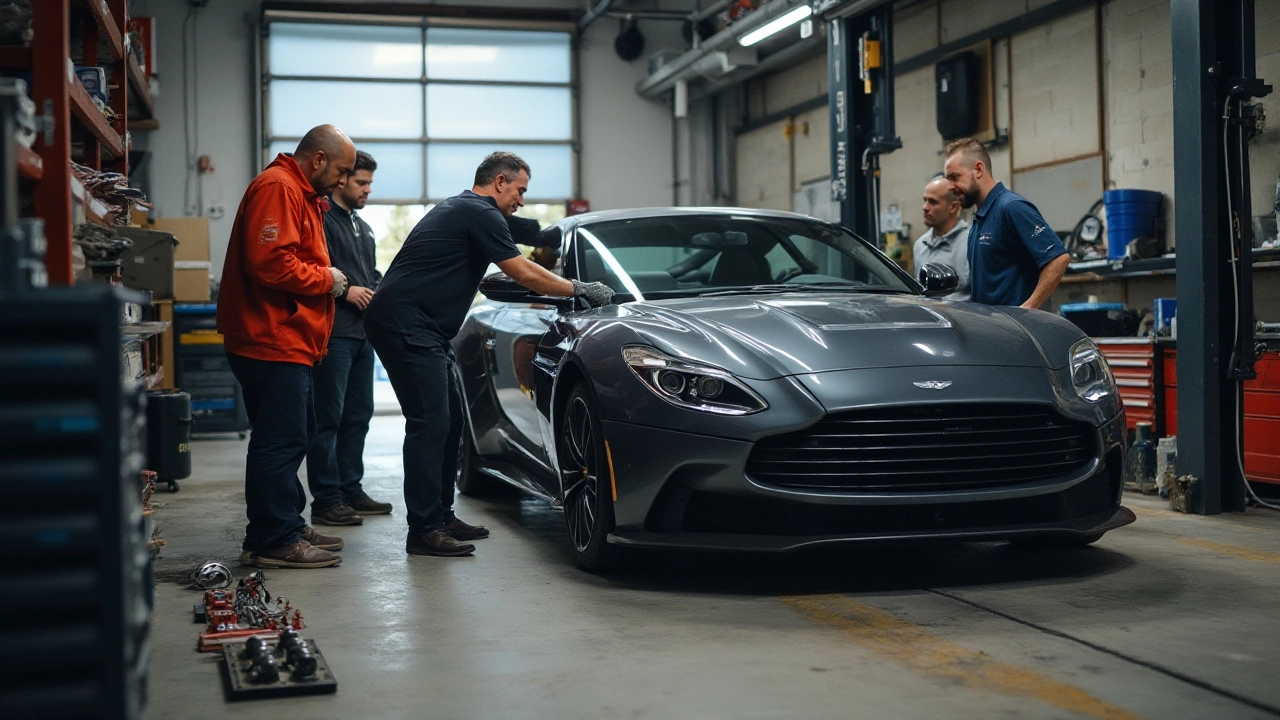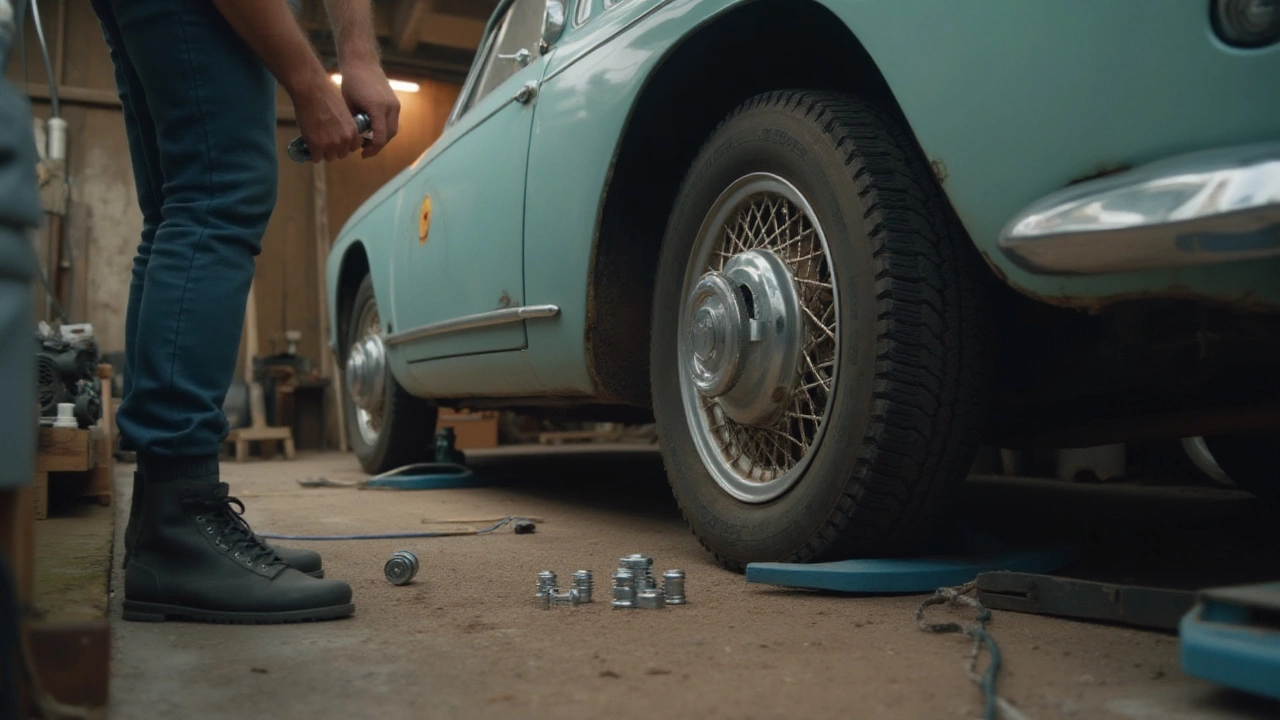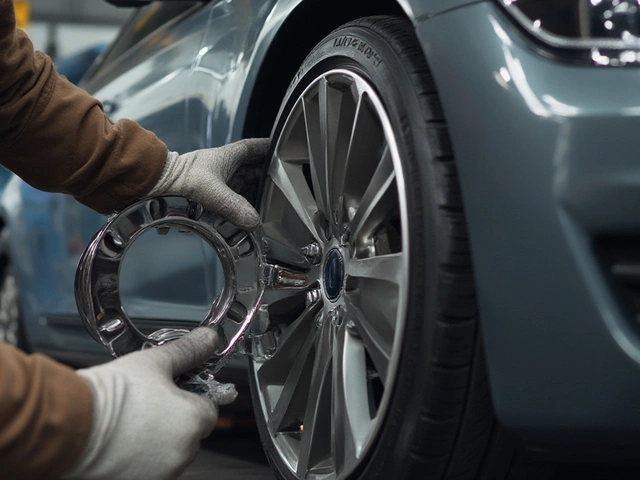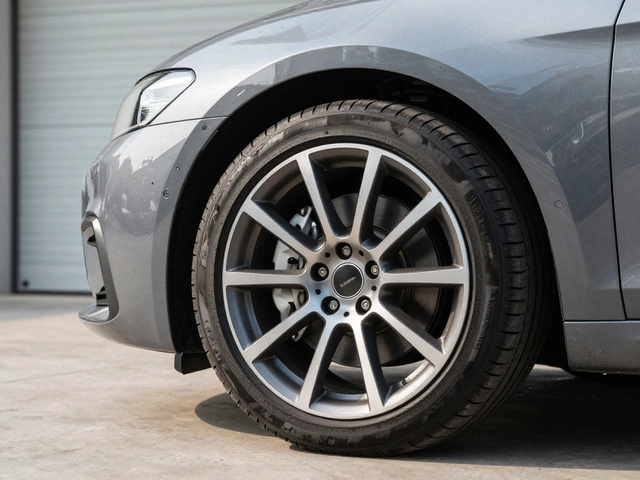Wheel spacers can be a game changer for car enthusiasts looking to adjust the stance of their vehicle or accommodate larger wheels. Yet, like any modification, they require careful consideration. Their function is to create extra clearance between the wheel and the hub, which can lead to numerous advantages if done correctly.
However, wheel spacers are not without potential drawbacks. Incorrect installation or selecting the wrong type can compromise safety and vehicle performance. Therefore, understanding their purpose and the implications of installing them is essential for anyone considering this modification.
In this article, we'll dive into what wheel spacers are all about, highlight both the benefits and the risks, and equip you with the knowledge needed to make informed choices for your car's journey.
- What Are Wheel Spacers?
- Benefits of Wheel Spacers
- Potential Risks
- Installation Tips
- Safety Considerations
- Troubleshooting Common Issues
What Are Wheel Spacers?
Wheel spacers might seem like just another car gadget to the uninitiated, but delve deeper, and you'll find that they play a significant role in the realm of car modifications. Essentially, a wheel spacer is a small device that creates a specific amount of space between the car's wheel hub assembly and its wheels. These devices are typically crafted from aluminum or steel for durability and strength. They alter the offset of the wheels, pushing them outward. This seemingly minor shift brings about changes in vehicle dynamics, aesthetics, and function.
Understanding why someone might choose to install wheel spacers is key. For one, they can enable the accommodation of larger brake calipers by offering the necessary clearance. This is crucial if you plan on upgrading your braking system to something more robust, but your current wheel and hub setup lacks adequate space. Another popular reason drivers opt for spacers is purely aesthetic. A widened wheelbase can give a vehicle a more aggressive stance and improve its road presence. When the wheels are flush with the car's fender, the look is undeniably sleek and premium.
"Wheel spacers have become a popular choice for those looking to enhance road grip and vehicle stability," notes automotive expert Julia Knight. "Properly installed, they can redefine the way your car interacts with the road."However, the benefits don't stop at looks. Installing wheel spacers can also positively influence car handling. By widening the track, spacers can improve lateral stability and cornering performance, providing a more planted and responsive experience. However, there is a coutionary tale in this modification. It's vital to remember that a misstep during installation, or selecting an incorrect size, may lead to adverse effects on suspension geometry and vehicle handling dynamics. In some circumstances, it may also increase wear on steering components or bearings.
Often overlooked, but equally significant, is the consideration of wheel spacer size. Spacers come in various thicknesses, and this variable directly affects how much further your wheels will stick out. Too thick, and you could run into issues with fender clearance and rubbing during tight maneuvers or suspension travel. Before choosing a spacer size, it’s advisable to measure your current setup and decide how much space is needed for your specific goals. The combination of wheels, tires, and intended use of the vehicle plays a crucial role in determining the right spacer.
Should you decide on installing wheel spacers, remember that not all kits are created equal. Brands vary widely in terms of manufacturing quality and material strength, so investing in a reputable manufacturer can mean the difference between a smooth ride and potential mechanical mishaps. Many drivers ensure they acquire hub-centric spacers, which sit perfectly centered on the hub, reducing the risk of aimless vibrations. Installing wheel spacers isn't a one-size-fits-all situation; it's a tailored experience akin to a bespoke suit fitting — the wrong dimensions can lead to discomfort, or worse.
Benefits of Wheel Spacers
Installing wheel spacers on your vehicle can have a multitude of benefits that cater to both aesthetics and performance. One of the most prominent advantages is the improved stance and appearance of your car. By pushing the wheels outwards, spacers provide a more aggressive and sportier look, giving the vehicle a stance that’s sure to turn heads. But the beauty isn't just skin deep. These spacers can also help accommodate larger wheels or brakes that wouldn't ordinarily fit within the factory wheel well. This is an invaluable feature for those looking to customize their vehicle with aftermarket wheels or high-performance braking systems.
Achieving optimal performance is another key benefit that draws enthusiasts towards car modifications like wheel spacers. They can enhance the steering response and stability of the vehicle by widening the track width, which lowers the center of gravity. This translates to better handling and cornering, especially noticeable during high-speed maneuvers. Some drivers report experiencing an improved grip on the road as the vehicle distributes weight more evenly across the tires. Such modifications can set the stage for a more exhilarating driving experience.
The benefits extend into the realm of practicality as well. By providing extra clearance between the tires and the vehicle body, wheel spacers can prevent tires from rubbing against the suspension components or fenders, which can be an issue with specific tire and wheel combinations. This additional space can mean the difference between excessive tire wear and seamless operation. Not only that, but the ease of accommodating various wheel offsets can simplify the process of finding and fitting aftermarket wheels, saving time and frustration.
A renowned automotive expert once said, "Wheel spacers bridge the gap between aesthetics and performance, unlocking potential in ways that wheels alone cannot."
Beyond appearances and handling, wheel spacers have been known to improve brake performance. The increased track width leads to more leverage when turning, which can enhance the effectiveness of the brakes. This is particularly beneficial in vehicles that frequently encounter demanding driving conditions. The added space can allow for better brake cooling, thus reducing the risk of overheating during intense driving sessions.
Finally, wheel spacers are often a cost-effective option compared to other modifications. They offer a simple solution to multiple problems without necessitating extensive vehicle alterations. This cost-efficiency, combined with the ability to change the look and feel of a car, makes them a popular choice among car enthusiasts. In essence, the investment in wheel spacers can pay off handsomely in terms of both functionality and aesthetics.

Potential Risks
Wheel spacers can seem like an easy and effective way to boost your car's appearance and performance by altering its stance. However, it's crucial to recognize the potential risks associated with their use. Installing wheel spacers incorrectly or choosing the wrong type can lead to more significant issues than anticipated. One of the primary concerns is the additional strain they place on the vehicle's suspension components. The further you push the wheel from the hub, the more leverage it has, which can overstress bearings and axles, leading to premature wear and failure. This issue is compounded in performance vehicles, where the forces experienced during aggressive driving can magnify these effects.
Another risk that often goes unnoticed is the potential for reduced steering responsiveness. By altering the geometry of your car's wheels, you inadvertently change the dynamics of its handling, which may lead to less precise steering or an increased tendency for under or oversteering. This is particularly problematic in adverse weather conditions where control is paramount. Moreover, installing wheel spacers incorrectly can result in poor wheel alignment, which not only affects handling but also accelerates tire wear and decreases fuel efficiency.
Security is another critical factor to consider. Not all wheel spacers are created equal, and using sub-standard products can be catastrophic. Cheap materials with poor workmanship may lead to accidents if they fail under stress. It is always advisable to invest in high-quality spacers from reputable brands. This sentiment was echoed by auto expert John Davis, who stated,
"Choosing quality in wheel spacers isn't just about performance; it's about ensuring safety on the road."
Moreover, depending on your location, the use of wheel spacers could impact the vehicle's legality, potentially leading to complications with insurance or roadworthiness tests. A quick check with local regulations can prevent unexpected hurdles.
Impact on Wheel Studs
Another often overlooked risk is the impact on wheel studs. Wheel spacers typically require extended lug bolts or a bolt-on design that fastens to existing studs and provides new ones. Both designs can have inherent risks if improperly executed. The resulting stress can sometimes lead to stud failure under heavy use. Regularly inspecting your wheel setup after installing spacers can help mitigate long-term risks associated with extended use.
While we can explore the benefits that wheel spacers provide, understanding and mitigating potential risks is crucial for maintaining your vehicle's safety and performance. Regular maintenance checks, opting for reputable brands, and being aware of your vehicle's specific requirements will serve you well when deciding to go down this modification path.
Installation Tips
Installing wheel spacers can be a rewarding endeavor if approached with careful preparation and precision. Before diving into the installation process, it is crucial to select the right type and size of spacers that suit your specific vehicle and intended usage. Begin by consulting your car’s manual to understand its unique wheel specifications. Remember, choosing the wrong spacer size can affect vehicle performance or, in worst-case scenarios, lead to safety issues. It’s advisable to invest in high-quality spacers made from durable materials like aluminum alloy, which offers an optimal balance of strength and weight.
Once you’ve acquired the appropriate spacers, the next step is ensuring all necessary equipment is on hand. You’ll require a jack, lug wrench, torque wrench, and possibly a thread locker or anti-seize lubricant. Preparation is key; ensure your workspace is clean and spacious enough to accommodate your vehicle's lift. Place wheel chocks behind your vehicle’s wheels to keep it stationary while being jacked up. Safety should always be prioritized, so wear protective gear if necessary.
According to Car and Driver, "properly installed spacers can enhance handling by widening the wheelbase, but attention to detail during installation ensures the best outcome."
With the vehicle secured, proceed to remove the wheels carefully. Loosen the lug nuts with a lug wrench in a star pattern to avoid stress on any individual nut. Once removed, clean the wheel hub to eliminate rust or debris that might prevent the spacer from sitting flush. Any dirt can disrupt the secure fit of the wheel spacers, leading to unwanted vibrations or imbalances. At this point, you might want to apply anti-seize lubricant to the hub's contact points.
Installation Process
Begin by aligning the wheel spacer with the hub's bolt pattern. Place it onto the hub, ensuring it sits perfectly without any gaps. Secure it in place with bolts or lug nuts depending on the style of your spacers. A torque wrench is essential here; tightening should follow the specified torque settings, which can usually be found in your spacer instruction manual. Over-tightening or under-tightening can introduce stress to the bolts, affecting the durability of the install.
After ensuring the spacers are adequately secured, reattach the wheel. Again, use the star pattern method to tighten the lug nuts. Always recheck the torque after a short test drive to ensure that nothing has loosened. It’s a small step but crucial in maintaining the safety and performance of the system. A properly installed wheel spacer not only adds to the aesthetic appeal by widening the track but also can improve handling in certain conditions.
Lastly, regular maintenance and checks are crucial to ensure that everything remains in top condition. Recheck the tightness of the spacers and the condition of the hub at regular intervals to spot any signs of wear that might necessitate replacement. By following these installation tips diligently, you can enjoy a new driving experience with your vehicle safely and efficiently.

Safety Considerations
When it comes to contemplating the inclusion of wheel spacers in your vehicle's setup, safety is undeniably the most critical factor to consider. Installing them might seem like a simple task, but it’s essential to recognize that any alteration to the factory settings of a car must be treated with the utmost precaution. Wheel spacers may alter the vehicle’s center of gravity, potentially impacting handling performance in both mundane and emergency situations. The radius between the hub and the wheel now sees a gap increase, which puts added stress on the car’s suspension components. Additionally, if these parts aren't properly torqued, they could potentially come loose during operation, risking detachment.
Ensuring the right type of wheel spacer is essential. There are primarily two types: hub-centric and lug-centric spacers. Hub-centric ones are designed to fit snugly around the hub, which is crucial for maintaining balance and minimizing vibration. Lug-centric spacers base their support on the lug nuts, which might not provide the same level of stability. This differentiation is crucial, and choosing the wrong one can lead to uneven pressure on the wheels, which could prematurely wear out the bearings and other associated components. Moreover, the material of the spacers—often aluminum or steel—plays a role in their longevity and strength.
Regular inspection post-installation is imperative. Like any component that experiences wear and tear, periodic checks ensure that the spacers are maintaining their integrity. Particularly, the bolts should be inspected periodically and re-torqued if necessary. It's also beneficial to verify alignment periodically because wheel spacers can subtly shift the dynamics of wheel alignment. Misalignment not only affects handling but can also lead to uneven tire wear.
Professional Guidance
Consulting with experts before making any changes can offer valuable insights. Mechanics experienced in vehicle modifications will ensure that the process is executed correctly, mitigating potential drawbacks. They can provide significant assurances that the selected options align perfectly with the vehicle’s specifications. According to a seasoned automotive engineer, “If installed and maintained properly, wheel spacers can be as safe as any factory part. The key is in the attention to detail during installation and ongoing maintenance.”Real-World Data
Research from various automotive studies suggest that improper fitting or poor-quality spacers cause the majority of issues associated with them. A recent survey conducted on 1,000 car enthusiasts using wheel spacers showed that 85% hadn't faced any issues when quality materials and professional installation methods were utilized. Only 15% reported problems, primarily attributed to incorrect installation or poor-quality products.Given these considerations, those interested in enhancing their vehicle’s aesthetics or performance with wheel spacers should approach the modification with a balance of enthusiasm and caution. By understanding the mechanics and being proactive about safety checks, the risk associated with this modification can be significantly minimized, allowing drivers to enjoy the benefits without compromising on security.
Troubleshooting Common Issues
When it comes to using wheel spacers, enthusiasts often find themselves facing a range of unexpected challenges. It's essential to distinguish between problems that genuinely stem from the spacers and those that may arise due to unrelated vehicle issues. Knowing where to start can save time and money and prevent frustration. One common issue users report is a noticeable vibration in the steering wheel after installation. This phenomenon often stems from the spacers not being perfectly centered when mounted. Ensuring they fit snugly and correctly against the hub can mitigate this issue.
Another frequent concern is the unusual noise emanating from the wheels. It often occurs when the lug nuts or the bolts holding the spacers are not torqued to the specified values. Consistently checking and maintaining torque specifications is critical for safety. Over-tightening can be as problematic as under-tightening, leading to potential damage or loss of parts.
Interestingly, wheel alignment can also be affected after adding spacers. It's a good practice to have your alignment checked post-installation. While you may not have adjusted camber or toe intentionally, slight shifts can affect handling and tire wear over time. Regular alignment checks help to keep your ride smooth and stable.
Some drivers face problems with the increased wear on wheel bearings. This issue is due to the change in load distribution caused by moving the wheels outwards. To diminish wear, selecting high-quality spacers that fit precisely and do not introduce excessive stress is vital. It's helpful to inspect wheel bearings periodically to catch any early signs of wear.
"Precision in fitting and adherence to installation guidelines are imperative for maximizing the benefits of wheel spacers while minimizing risks," advises Tom Merritt, a renowned automotive engineer. His advice highlights the importance of careful attention to detail during and after the installation process.
Lastly, rust and corrosion can occasionally become an issue, particularly in regions with high humidity or where road salt is commonly used. To prevent corrosion, it is advisable to use rust-proofing treatments on both the spacers and the hub surfaces. Keeping these components clean and dry extends their lifespan and maintains optimal performance.




